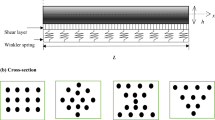Abstract
Construction of numerical models which reliably describe the processes of crack formation and development in reinforced concrete permit estimating the bearing capacity and structural strength of any structural element without using expensive full-scale experiments. In the present paper, an example of four-point bending of a rectangular beam is used to consider a finite-element model of concrete fracture. The results obtained by quasistatic calculations and by solving the problem with inertia forces taken into account are compared. The kinetic energy contribution to the total mechanical energy of the system at the crack origination moment, which is greater than 30%, is estimated to justify the expediency of taking the inertia forces into account. The crack distribution characters obtained numerically and observed experimentally are compared. It is shown that the leading role in the evolution of the crack formation process is played by the mechanism of fracture of bonds between the reinforcing elements and the concrete.
Similar content being viewed by others

References
Yu. P. Skachkiov, “Determinations of Fracture and Crack Formation Schemes in Short Reinforced Concrete Beams from Experimental Data,” Region. Arkhitekt. Stroit., No. 3, 74–82 (2013).
V. M. Strulev and R. A. Yarkin, “Mechanism of Fracture and Methods for Increasing the Bearing Capacity of Flexible Reinforced Concrete Elements,” Vestnik TGTU 6 (3), 474–477 (2000).
G. Ruiz, M. Elices, and J. Planas, “Experimental Study of Fracture of Lightly Reinforced Concrete Beams,” Mater. Struct. 31, 683–691 (1998).
A. Carpinteru, J. R. Carmona, and G. Ventura, “Failure Mode Transitions in Reinforced Concrete Beams, Part 2: Experimental Tests,” ACI Struct. J. 108 (3), 286–293 (2011).
A. A. Bykov, V. P. Matveenko, G. S. Serovaev, et al., “Mathematical Modeling of Vibration Processes in Reinforced Concrete Structures for Setting Up Crack InitiationMonitoring,” Izv. Akad. Nauk. Mekh. Tverd. Tela, No. 2, 60–72 (2015). [Mech. Solids (Engl. Transl.) 50 (2), 160–170 (2015)].
SP 63. 13330. 2012. Concrete and Reinforced Concrete Structures. Foundations. Actualization of SNiP 52-01-2003 (Minregion Rossii, Moscow, 2012) [in Russian].
SP 52-101-2003. Concrete and Reinforced Concrete Structures without Prestressed Reinforcement (GUP “NIIZhB”, FGUPTsPP, Moscow, 2004) [in Russian].
GOST 8829-94. Factory-Made Reinforced Concrete and Concrete Structural Products. Loading Tests Methods. Rules for Estimating the Strength, Rigidity, and Crackresistance (Gosstroi Rossii GUPTsPP, Moscow, 1997) [in Russian].
D. Kachlakev and T. F. E. Miller, Modeling of Reinforced Concrete Structures Strengthened with FRP Laminates, Final Report (Oregon Department of Transplantation, 2001).
Y. R. Rashid, “Analysis of Prestressed Concrete Pressure Vessels,” Nuclear Engng Des. 7 (4), 334–344 (1968).
H. G. Kwak and C. F. Flippou, Finite Element Analysis of Reinforced Concrete Structures under Monotonic Loads, Report (Univ. of California, Berkely, 1990).
L. Dahmani, A. Khennane, and S. Kaci, “Crack Identification in Reinforces Concrete Bemas Using ANSYS Software,” Probl. Prochn., No. 2, 141–153 (2010) [Strength of Materials (Engl. Transl.) 42 (2), 232–240 (2010)].
A. J. Wolansky, Flexural Behavior of Reinforced and Prestressed Concrete Beams Using Finite Element Analysis, Thesis (Marquette University, 2004).
A. F. Barbosa and G. O. Ribeiro, “Analysis of Reinforced Concrete Structures Using ANSYSNonlinear Concrete Model,” in Proc. of Comp. Mechanics. New Trends and Applications, Barcelone, 1998 (Barcelone, 1998).
V. B. Dawari and G. R. Vesmawala, “Application of Nonlinear ConcreteModel for Finite Element Analysis of Reinforced Concrete Beams,” Int. J. Sci. Engng Res. 5 (9), 776–782 (2014).
A. B. Rasmussen, Analytical and Numerical Modeling of Reinforced Concrete in Serviceability Limit State, Thesis (Aarhus University, 2012).
D. Ngo and A. C. Scordekus, “Finite Element Analysis of Reinforced Concrete Beams,” J. ACI 64 (3), 152–163 (1967).
A. L. Gamino, J. L. A. O. Sousa, and O. L. Manzoli, “A Comparative Study between Smeared and Embedded Crack Models for Finite Element Analysis of Reinforced Concrete Beams,” in Proc. of FraMCo S. Korean Concrete Institute, 2010.
K. J. William and E. P. Warnke, “Constitutive Model for the Triaxial Behavior of Concrete,” Proc. Int. Associat. Bridge Struct. Engng 19, 1–30 (1974).
A. I. Lurie, The Theory of Elasticity (Nauka Moscow, 1970) [in Russian].
W. Nowacki, Theory of Elasticity (PWN, Warsaw, 1970; Mir, Moscow, 1975).
N. N. Malinin, Applied Theory of Plasticity and Creep, Manual for students of higher educational institutions, 2nd. ed. (Mashinostroenie, Moscow, 1975) [in Russian].
K. J. Bathe, Finite Element Procedures (Prentice Hall, Englewood Cliffs, HJ, 1996).
Author information
Authors and Affiliations
Corresponding author
Additional information
Original Russian Text © A.A. Bykov, V.P. Matveenko, G.S. Serovaev, I.N. Shardakov, A.P. Shestakov, 2015, published in Izvestiya Akademii Nauk. Mekhanika Tverdogo Tela, 2015, No. 4, pp. 118–129.
About this article
Cite this article
Bykov, A.A., Matveenko, V.P., Serovaev, G.S. et al. Analysis of the influence of dynamic phenomena on the fracture of a reinforced concrete beam under quasistatic loading (computations and experiment). Mech. Solids 50, 463–472 (2015). https://doi.org/10.3103/S0025654415040123
Received:
Published:
Issue Date:
DOI: https://doi.org/10.3103/S0025654415040123



